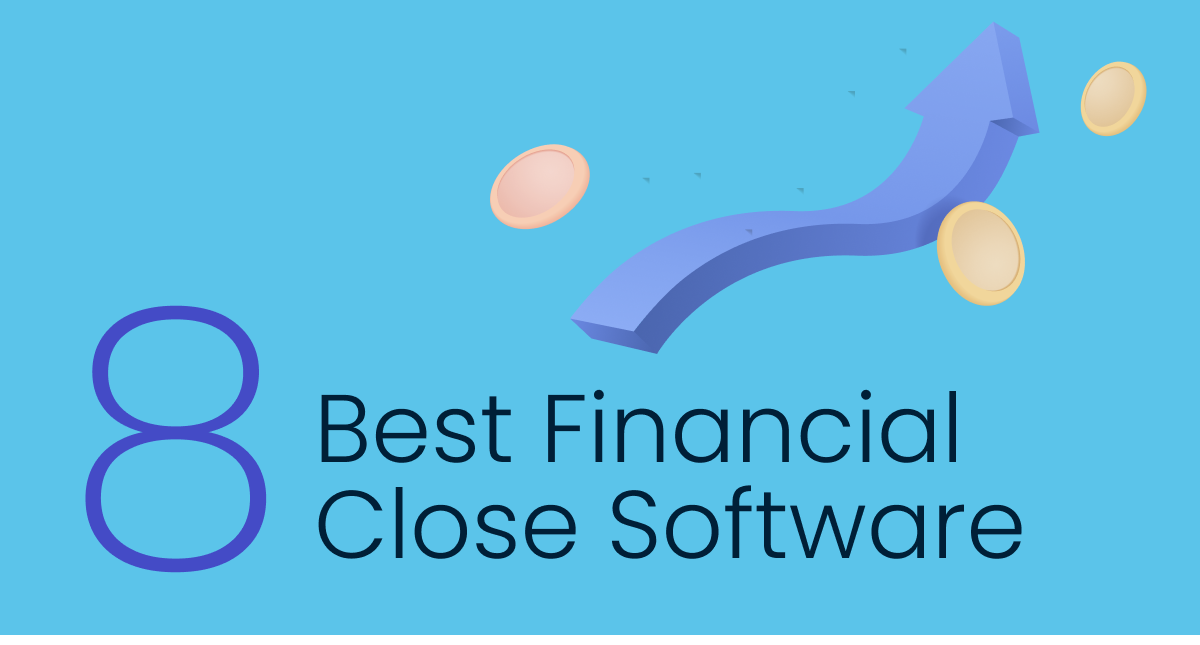
The financial close process is one of the most time-consuming activities for finance teams – quite simply because it seems to happen all the time.
- There is the month-end close.
- Then there’s the quarterly financial close.
- Then there is the financial year-end close.
Finance teams seem to always be behind in the financial close process.
Out of all the financial processes to automate – budgeting, forecasting, and consolidation – upgrading your financial close process can save your company the most time and headache, simply because it is done so often.
Our month end close process guide goes over in great detail all of the steps and benefits of the financial close process, so here’s just a quick refresher before diving in.
What is the financial close process?
The financial close process, otherwise known as “closing the books” (finalizing numbers and financial statements for certain periods) can be done monthly, quarterly or yearly.
When doing a financial close, finance and FP&A teams will review and adjust balances, and adjust journal entries.
The point of the financial close is to find mistakes, create management reports and audits, and most importantly, take action from the data.
The problem that companies run into when collecting, organizing, and reporting all of the data is the process is too long and they don’t have enough time to actually analyze the data and take action based on the findings.
That’s where financial close software comes in.
Benefits of Financial Close Software
- Speeds up your financial close process. Some financial close software has cut companies’ month-end close process times by 50-80%!
- Less human error and greater accuracy.
- Better collaboration across the finance team as well as with management.
- With audit control or audit trail, you can control who has access to edit certain data and see a history of what was changed by whom. All of this can be tracked.
- Custom workflows to fit each finance team’s particular processes.
Top 8 Financial Close Software
1) Datarails
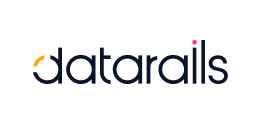
Datarails is a financial close software that is part of a complete FP&A software that improves all of your finance needs. The entire financial reporting process becomes easier as Datarails reduces the repetitive, error-prone tasks needed to collect data for your P&L, balance sheet, and cash flow statements.
Datarails case studies with Financial Close:
- MyCarrier is a shipment company that automates 2.5 million shipments annually. They used to manually map or export all of their financials from QBO, put them in a spreadsheet, and then change all of the formulas. Now with Datarails it’s all done automatically, takes far less time, and doesn’t contain errors.
- Echo Engineering is a manufacturing company that supplies parts to customers in the heavy machinery and automotive industries. Before using Datarails it would take the finance team five days to conduct the financial close process. Now they do it in two and have more accurate and up-to-date numbers that allow them, among other things, to access customer margin analytics. They now use that information to make targeted price increases as well as identify and resolve payment gaps among customers – all of which greatly increased their bottom line profit.
Features of Datarails’ financial close software:
- Excel native software means that finance teams don’t need to change their data environments or spend time learning a new system.
- Audit control – Datarails’ system allows you to control who can edit which data, along with an audit trail that tracks when changes were made and by whom.
- Data consolidation – Consolidating data into one system helps the financial close process go smoother, quicker, and more accurately.
- Dashboards and AI insights allow finance teams to focus on decision making by creating automated dashboards from real time data.
Cons:
- Datarails financial software is built for small and medium sized businesses and is not suited for individuals or large enterprises.
Pricing:
- Datarails doesn’t provide direct pricing on their website.
2) LucaNet

LucaNet is a CPM software for finance teams that is used for accelerating financial close and consolidation, planning, and reporting. While it is not as complete a tool as many FP&A software products that cover all of the finance department needs, it focuses more on consolidation and financial close, which makes it a great tool for conducting the month or year end close.
LucaNet case studies with financial close:
- ABL-TECHNIC is a construction company based in Germany that started using LucaNet software. It helped them increase the quality of their data, accelerated their reporting processes, and provided them with more precise account mapping. In addition, LucaNet upgraded their IC reconciliation down to an account basis and provided them with a centralized data warehouse.
- Energy company BlueLeaf needed a quick implementation due to unexpected management changes and time pressures. Implementation was completed in 7 days and the team can now carry out their consolidation duties at ease. They also eliminated unnecessary versioning of Excel reports and now collaboratively work on reports to perform meaningful analysis instead of all of the time spent on collecting data.
Features of LucaNet financial close software:
- Real-Time Collaboration: LucaNet enables users to collaborate on financial close operations in real time, allowing teams to work together more efficiently while improving accuracy and reducing errors.
- Integrated Workflows: LucaNet provides integrated workflow capabilities that help companies streamline the financial close process by automating tasks.
- Detailed data analysis and reporting capabilities.
- Multi-currency conversion and translation.
Cons:
- It does not offer many options for integrating with third-party systems, which makes it difficult to customize processes and automate certain tasks.
- It has slower adoption rates than some of its competitors due to lack of awareness and understanding about the software.
LucaNet pricing
- LucaNet doesn’t provide pricing on their website but they have different pricing tiers.
3) Board
Board is an FP&A software that caters to all sizes of businesses – small, mid market, and enterprise. While some of its budgeting and forecasting features aren’t as popular as other FP&A solutions, Board’s financial close software is quite good thanks to its easy-to-use interface and the ability to create and audit financial reports quickly and easily.
Board case studies with financial close:
Coca-Cola European Partners uses Board for its financial automation. It has helped them gain complete visibility of supply chain activities and they have seen a dramatic increase in overall planning efficiency and saved a lot of time on their heavy financial close processes
Agribusiness specialist Syngenta started using Board for self-service reporting and function cost reporting. It cut down tremendously on their financial close time and provided them the flexibility to adapt to ever-changing requirements in the industry.
Features of Board financial close software:
- Custom and template reporting.
- Intuitive user interface for financial consolidation and close.
- Workflow automation for approvals.
- Board integrates with existing systems in order to automate many of the time-consuming processes associated with the financial close.
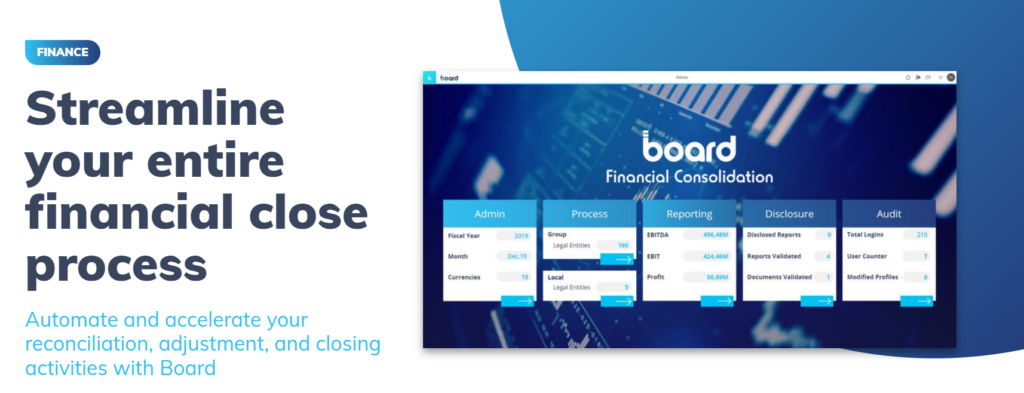
Cons:
- Features are limited in terms of customization options, making it difficult to tailor the software to the company’s specific needs.
- Longer implementation time than most software and may require extensive setup, especially for companies with a lot of data.
Board Pricing:
- Board’s pricing varies depending on the size of the business. Their pricing is by customized quote only.
4) Blackline
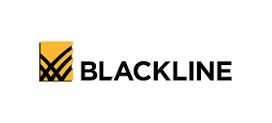
Blackline is different from most of the other software on the list as it is a cloud-based financial operations management platform specifically designed for automating the financial close process. Due to this, its financial close software is above average, but it doesn’t provide a great solution for other finance tasks that companies are looking to automate.
Blackline case studies for financial close:
- MedComp Sciences, a pharmacogenetic services company, integrated Blackline. Before then, it would take three finance team members a full week to conduct the month-end close. Afterwards, the financial close times were done five times faster and with far fewer mistakes.
- When nonprofit liberal arts college Naropa University started using Blackline they discovered they had 2000 General Ledger accounts they weren’t using. It then allowed them to dive deeper into their data and make smarter financial decisions.
Features of Blackline financial close software:
- Pre-built reports make its reports standardized.
- Drillable dashboards.
- Automated journal entries.
- Automated substantiation and testing to help companies remain compliant with regulations.
Cons:
- Lack of integration into certain business applications tends to cause compatibility issues that can lead to disruption during the close process.
- The onboarding process can be time consuming even though it is customized just for the financial close process.
- Not built for large enterprises or those with complex close processes.
Blackline Pricing:
- Blackline does not provide specific pricing plans on their website.
5) Fluence

Just like Blackline, Fluence is specifically built for the financial close process and financial consolidation. Its interface is easier to use as it is meant for mid-size businesses and just like Datarails it offers a native Excel interface for easier integration.
In April, 2024, Fluence was bought by FP&A software solution Anaplan and is now integrated into their product.
Features of Fluence financial close software:
- Self service and intuitive reporting means that companies don’t need outside support and minimal implementation time.
- Fluence claims it can reduce the amount of time it takes to do the financial close by 80%.
- Drag and drop workflows.
- Powerful journal entry tools that allow users to easily enter and manage transactions through a centralized interface.
- Secure audit trail.
Cons:
- Reporting features are not as comprehensive as other software.
- Limited integrations with other applications or services.
- Easy to use workflows but limited customization capabilities.
- Now part of Anaplan so need to pay for their whole software and implementation in order to get Fluence’s financial close feature.
Fluence Pricing:
- Fluence does not have a pricing section on their website. Customers need to contact Anaplan for a quote.
6) Floqast
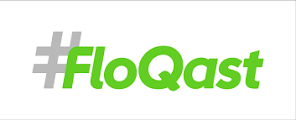
Floqast is the last of the three on this list that is exclusively a financial close software. They also focus on collaboration, which aims to reduce errors and increase the speed at which management can make decisions.
Floqast case studies with the financial close:
- Cybersecurity company Venafi found their monthly close process got longer and longer until it eventually reached 15 business days to conduct the month end close. They adopted Floqast and tools like the integrated email sign-offs and quick reference task dashboards allowed them to cut down their month end close to 10 days.
- Stack Overflow, the largest online developer community, used to conduct “soft month end closes”, meaning they wouldn’t complete specific or detailed tasks, rather just go over their numbers not in full detail. Floqast created a standardized process, reducing time and making it much more organized through the real-time dashboard.
Floqast financial close software features:
Its automated currency conversion feature simplifies data processing and ensures accuracy in multi-currency scenarios.
- Reporting suite allows users to track progress in real time and quickly generate insights into their financial close cycle.
- Personalized customer support, offering individualized training sessions and ongoing advice.
- Customizable and configurable tax packages that allow users to generate their tax returns automatically.
- Floqast is an AI accounting software that automates the financial close even faster with their new AI features.
Cons:
- The system is intuitive but it’s also not as comprehensive and thorough as some of its competitors.
- Its lack of integration with other systems can be an issue for companies that are already using multiple solutions.
- Floqast does not provide a mobile app.
Floqast pricing
- Floqast does not have a pricing page on their website.
7) Oracle financial Consolidation
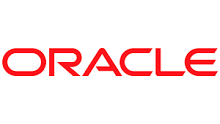
Oracle Financial Consolidation and Close Cloud is one of Oracle’s many financial software services that automates financial processes. This tool is specifically designed for the financial close process, but Oracle provides many other software tools and most customers combine financial consolidation with them.
Oracle financial close software features:
- Oracle is one of the most popular financial software tools so it naturally comes with many integrations, especially for those who use Oracle’s other services.
- Many analytics and reporting tools help do more with the financial close.
- Handles large amounts of data and changing business environments.
- Predefined workflows and approval processes for financial close.
Cons:
- Implementing Oracle can be lengthy and expensive.
- Best for large companies and enterprises who want to commit to a long term solution.
- Does not offer detailed analytics in terms of its financial close process.
Oracle pricing
- Oracle doesn’t have pricing for their financial close software as pricing depends on your software package and number of users. They do have some interesting pricing tools and information on their site, including this Oracle Cost Estimator tool.
8) Workiva
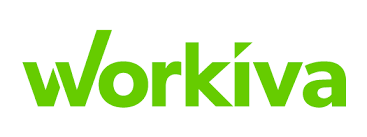
Workiva is an FP&A software meant for financial close, audit and risk, and ESG, mostly for large companies and enterprises. They put a focus on connected data (along with audit and risk) which helps finance teams make the most of their automated and simplified financial close process, as they can now use that information for more data-driven decision making.
Workiva case studies with financial close
- Playa Hotels & Resorts was going public and had a lot of data and processes to change. In addition to helping them with all of the compliance and reports, Workiva cut down their financial close from 10 days to 4 days.
- A big utility company integrated Workiva. Before using the software they would have to decide whether to meet a deadline or give the data the analysis it deserves. Now, instead of having to make that decision each month, automation and data connectivity allows them to finish their financial close in plenty of time to conduct analysis and present decisions to management.
Workiva financial close software features:
- Custom financial close documentation.
- Auto-generation and distribution of reports.
- Comprehensive access controls that allow users to configure who has access to different areas of their financials.
Cons:
- Workiva requires a significant amount of training and configuration before it can be used to its full capacity
- The reporting feature has limited customization abilities.
- Workiva is reported to be pricier than other similar competitors.
Workiva pricing:
- Workiva doesn’t provide pricing quotes on their website. You can book a demo and get more information, including pricing.
Conclusion
There are many different types of financial close software. Each has many pros and cons and different features, so the choice can be difficult depending on your budget and finance needs. Some software are exclusively built for the financial close process, while others improve broader aspects of FP&A and beyond. For those looking for a complete finance software that covers financial close, budgeting, forecasting, and saves dozens of hours on the month end close, then Datarails could be a good fit for you.
We hope this list helps you narrow down your search!